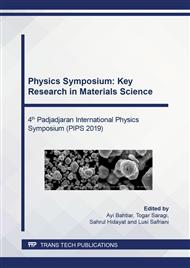[1]
Information on https://www.nrel.gov/pv/cell-efficiency.html.
Google Scholar
[2]
Q. Jiang, D. Rebollar, J. Gong, E.L. Piacentino, C. Zheng, T. Xu, Pseudohalide-induced moisture tolerance in perovskite CH3NH3Pb(SCN)2I thin films, Angew. Chem. Int. Ed. 54 (2015) 7617–7620.
DOI: 10.1002/anie.201503038
Google Scholar
[3]
Y. Chen, B. Li, W. Huang, D. Gao, Z. Liang, Efficient and reproducible CH3NH3PbI3−x(SCN)x perovskite based planar solar cells, Chem. Commun. 51 (2015) 11997–11999.
DOI: 10.1039/c5cc03615a
Google Scholar
[4]
A. Halder, R. Chulliyil, A.S. Subbiah, T. Khan, S. Chattoraj, A. Chowdhury, S.K. Sarkar, Pseudohalide (SCN−)-doped MAPbI3 perovskites: a few surprises, J. Phys. Chem. Lett. 6 (2015) 3483–3489.
DOI: 10.1021/acs.jpclett.5b01327
Google Scholar
[5]
Q. Tai, P. You, H. Sang, Z. Liu, C. Hu, H.L.W. Chan, F. Yan, Efficient and stable perovskite solar cells prepared in ambient air irrespective of the humidity, Nat. Commun. 7 (2016) 11105.
DOI: 10.1038/ncomms11105
Google Scholar
[6]
W. Ke, C. Xiao, C. Wang, B. Saparov, H.-S. Duan, D. Zhao, Z. Xiao, P. Schulz, S.P. Harvey, W. Liao, W. Meng, Y. Yu, A.J. Cimaroli, C.-S. Jiang, K. Zhu, M. Al-Jassim, G. Fang, D.B. Mitzi, Y. Yan, Employing lead thiocyanate additive to reduce the hysteresis and boost the fill factor of planar perovskite solar cells, Adv. Mater. 28 (2016) 5214–5221.
DOI: 10.1002/adma.201600594
Google Scholar
[7]
M.K. Kim, T. Jeon, H.I. Park, J.M. Lee, S.A. Nam, S.O. Kim, Effective control of crystal grain size in CH3NH3PbI3 perovskite solar cells with a pseudohalide Pb(SCN)2 additive, CrystEngComm. 18 (2016) 6090–6095.
DOI: 10.1039/c6ce00842a
Google Scholar
[8]
Y.-H. Chiang, H.-M. Cheng, M.-H. Li, T.-F. Guo, P. Chen, Low-pressure vapor-assisted solution process for thiocyanate-based pseudohalide perovskite solar cells, ChemSusChem. 9 (2016) 2620–2627.
DOI: 10.1002/cssc.201600674
Google Scholar
[9]
Y. Sun, J. Peng, Y. Chen, Y. Yao, Z. Liang, Triple-cation mixed-halide perovskites: towards efficient, annealing-free and air-stable solar cells enabled by Pb(SCN)2 additive, Sci. Report, 7 (2017) 46193.
DOI: 10.1038/srep46193
Google Scholar
[10]
Y.-H. Chiang, M.-H. Li, H.-M. Cheng, P.-S. Shen, P. Chen, Mixed cation thiocyanate-based pseudohalide perovskite solar cells with high efficiency and stability, ACS Appl. Mater. Interfaces 9 (2017) 2403–2409.
DOI: 10.1021/acsami.6b13206
Google Scholar
[11]
Y. Zou, Z. Zhang, Y. Cai, H. Liu, Q. Qin, Q. Tai, X. Lu, X. Gao, L. Shui, S. Wu, J.-M. Liu, High performance planar perovskite solar cells based on CH3NH3PbI3−x(SCN)x perovskite film and SnO2 electron transport layer prepared in ambient air with 70% humidity, Electrochim. Acta 260 (2018) 468–476.
DOI: 10.1016/j.electacta.2017.12.076
Google Scholar
[12]
A. Bahtiar, M. Putri, E.S. Nurazizah, Setianto, T. Saragi, Risdiana, M. Yamashita, S. Ikawa, Y. Furukawa, J-V characteristic of perovskite solar cells using lead(II) thiocyanate doped-methylammonium lead iodide (MAPbI3) as active material, J. Phys.: Conf. Ser. 1080 (2018) 012012.
DOI: 10.1088/1742-6596/1080/1/012012
Google Scholar
[13]
Q. Wang, Y. Chen, Y. Zheng, N. Ai, S. Han, W. Xu, Z. Jiang, Y. Meng, D. Hu, J. Peng, J. Wang, Y. Cao, Solvent treatment as an efficient anode modification method to improve device performance of polymer light-emitting diodes, Org. Electron. 14 (2013) 548–553.
DOI: 10.1016/j.orgel.2012.11.025
Google Scholar
[14]
H. Liu, X. Li, L. Zhang, Q. Hong, J. Tang, A. Zhang, C.-Q. Ma, Org. Electron. 47 (2017) 220–227.
Google Scholar
[15]
D. Zhao, M. Sexton, H.-Y. Park, G. Baure, J.C. Nino, F. So, High-efficiency solution-processed planar perovskite solar cells with a polymer hole transport layer, Adv. Energy Mater. 5 (2015) 1401855.
DOI: 10.1002/aenm.201401855
Google Scholar
[16]
K. Nakamoto, Infrared and Raman spectra of inorganic and coordination compounds, Part B, fifth ed., John, Wiley & Sons, New York, 1997, p.121–123.
Google Scholar


